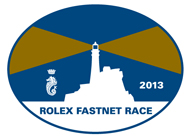
Always Challenging Forever International - Rolex Fastnet Race 2013
COWES/PLYMOUTH, UK
Over 20 different nations from four continents are represented at the 2013 Rolex Fastnet. Around 40% of fleet and half the sailors are non-British. The biennial event, one of the world’s great ocean races and sponsored by Rolex since 2001, is globally revered and recognised.
From the United States to Russia, the United Arab Emirates to Australia, the fleet reflects the continued international reach of the sport of offshore yacht racing pitting together the finest professional sailors and passionate Corinthians. From young Omani female sailor Raiya al Habsi, taking on the event for the first time, to 83-year old Dutchman Piet Vroon making the nautical pilgrimage to the Fastnet rock for a 25th time, the allure is irresistible.
The majority of the record-breaking 336 race starters share two common goals: the first naturally enough is to finish this 611-nautical mile test of skill and character. The second is to win the event overall and to claim the coveted Rolex Fastnet Challenge Cup and Rolex timepiece.
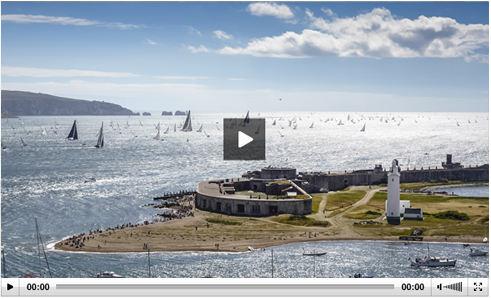
A record breaking fleet of 335 yachts start the 45th Rolex Fastnet Race
American influence
At the inaugural Fastnet in 1925 – a race inspired by the United States’ classic Newport-Bermuda Race created in 1906 - all seven of the competing yachts flew British flags. A touch of foreign influence was still prevalent: Saladwin was sailed by Ingo Simon, a Spaniard, and the race’s first winner Jolie Brise was constructed in Le Havre, France. A year later the race welcomed its first official overseas entry, the American schooner Primrose. Her participation was announced in the New York Times, a sign of the event’s instant reputation across the Atlantic.
American boats have defined eras in the race. In 1928, Paul Hammond’s Nina was the country’s first winner, causing some controversy for its pursuit of speed and ruthless desire to win in an era where a more gentile sailing was considered ‘appropriate’. American yachts, typically faster and more sophisticated than their British counterparts of the time, dominated the 1930s. Dorade – designed and sailed by Rod and Olin Stephens – claimed victories in 1931 and 1933, Stormy Weather in 1935, Elizabeth McCaw took line honours in 1937. In the 1950s, it was the turn of Carina who secured back-to-back handicap successes in 1955 and 1957. A decade later and Ted Turner came to prominence with his groundbreaking American Eagle, claiming line honours in 1969 and 1971 with a race record to boot. Turner also triumphed with Tenacious in the tragic 1979 race. Only one American boat – Great News – has won the Rolex Fastnet Challenge Cup since although Nirvana set a race record in 1985.
The Rolex Fastnet is an iconic race.
It’s tactically and strategically challenging.
That’s why we are here." - Hap Fauth, Bella Mente (USA)
A clutch of American boats have entered again this year, including the extremely competitive 72-ft Bella Mente, owned by Hap Fauth current Mini Maxi Rolex World Champion. This is Fauth’s first Rolex Fastnet, and he happily concedes he is the ‘senior rookie’ in his crew: “The Rolex Fastnet is an iconic race noted for very difficult conditions. It’s tactically and strategically challenging. It has very dangerous and frustrating moments. That’s why we are here. It’s extraordinary to put this many boats in a race: from 130-ft down to 30-ft. Its a great statement by the organizers.”
The 1960s marked a new era of the event and the globalisation extended to Australia whose sailors brought heightened professionalism and dedication. Australian success arrived in the shape of the legendary Syd Fischer’s Ragamuffin the winner in 1971, a year marked by the participation of acting British Prime Minister Edward Heath.
Channel hoppers
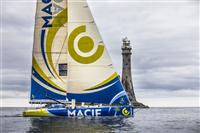 |
| Macif (FRA) at the Fastnet Rock |
The largest overseas contingent comes from France with in excess of 50 boats at this year’s Rolex Fastnet. Back in 1928 L’Oiseau Bleu was the first French-owned vessel to start the race, although it wasn’t until Guerveur appeared in 1929 that a French boat completed the course. In 1965, Baron de Rothschild’s Gitana IV – one of the last heavy yawls to win the race – broke the 26-year race record. The crew were said to change attire each evening for a sit down dinner served to them. Overall French victory eventually arrived two years later under the guise of Pen-Duick III skippered by the legendary Eric Tabarly. Three French winners have followed, most recently the 33-ft Iromiguy in 2005.
François Gabart, this year’s Vendée Globe winner and co-skippering the IMOCA 60 Macif in 2013, is one of the latest generation of top French offshore sailors. “The Rolex Fastnet is very famous and prestigious in France. Since I was a kid I have thought about competing in this race. For a professional sailor to sail against non-professional sailors is nice, mixing with people who just love sailing. I’m proud to be part of this event.”
Going global
No yacht has travelled further to the 2013 Rolex Fastnet than Australian Geoff Boettcher’s 51-ft Secret Men’s Business 3.5 from Adelaide. Given the logistical challenge it has taken to transport his yacht 16,000 miles to the UK, Boettcher is not here to simply make up the numbers. “As an Australian to come and do a Rolex Fastnet is huge. We’ve done so many Rolex Sydney Hobarts (the world’s other great 600-nautical mile offshore race which Secret Men’s Business 3.5 won in 2010), this is a great add-on to the crew’s career in sailing. We’re looking for a podium finish.” Boettcher is not the only former Australian Rolex Sydney Hobart winner in attendance. Andrew Saies (whose Two True won in 2009) is competing with a largely Australian crew on Two True Tarka.
Southern hemisphere success has not been confined to Australia. New Zealand with Ross Field’s RF Yachting took line honours and a race record in 1999. Neville Crichton won line honours in 2003 with Alfa Romeo and one of the country’s greatest sailors is back this year. “The Rolex Fastnet is one of the classics of our sport. It’s very tactical, challenging and great competition, all facets that we love. I’ve got wonderful memories of the race,” revealed Mike Sanderson, ISAF Rolex World Sailor of the Year in 2006, tactician on Bella Mente.
 |
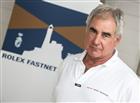 |
 |
 |
| Two True Tarka |
Geoff Boettcher |
Secret Men's Business |
Fastnet Rock at dawn |
South America’s one and only victory arrived courtesy of Saga from Brazil in 1973. The Middle East has confirmed its blossoming emergence in competitive sailing with Abu Dhabi Ocean Racing, skippered by British Olympian Ian Walker, winning line honours and claiming the monohull race record in 2011. This year, Middle Eastern interest is extended with the participation of Oman Air Musandam.
Swedish heritage
 |
| Ran 2 (GBR), two-time winner race winner |
Sweden is another country with a particular affiliation with the Rolex Fastnet. Success first arrived in the 1950s. Circe (1951) and Anna Marina (1959) claimed line honours while Sven Hansen’s Sparkman & Stephens Anitra was overall winner in 1959.
In the late 1990s, Sweden was again a dominant force at the front end of the fleet with the same boat, originally named Nicorette and then Royal Blue, achieving line honours in 1995 and then again in 1997. The link with the event remains strong. Overall winner in 2009 and 2011 the Mini Maxi Rán 2 sails under the British flag with predominantly British crew. Owner Niklas Zennström, however, is a Swede, and Rán 2 carries the initials of the Royal Swedish Yacht Club on its stern. The history of the race has had a marked impact on Zennström. “You take that trophy (the Rolex Fastnet Challenge Cup) and you see the plaques with all of the names of the yachts. There is a lot of history there, you see all the names, a lot of classic boats, boats that as a kid you watched and read about it.”
Homeward bound
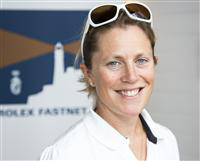 |
| Sam Davies, navigator on TEAM SCA |
Among this myriad of international yachting powers is Ireland, home to the race’s emblematic symbol - the Fastnet Rock. Only one Irish boat – Chieftain in 2007 –- has ever won the event. Trying to improve upon that statistic is this year’s 12-strong Emerald Isle contingent including Ker 39 Antix, whose crew includes Anthony O’Leary and his son Peter. “The Rolex Fastnet is on the bucket list,” explained Peter, who competed at the 2012 Olympics. “I learnt to sail in Baltimore as a youngster and used to go out and watch the boats going around the Fastnet Rock. I grew up wanting to do the race. My father has done it and my mother did it in ’79. A good few boats will come out in Baltimore to see us pass the Rock although it will be strange disappearing and returning back to England.”
Professional British sailors who have sailed throughout the world still find the draw of the race irresistible. “The Rolex Fastnet Race is the one of the top offshore races in the world,” revealed Sam Davies, navigator on Volvo 70 Team SCA, a predominantly female crew. “I remember when I was young watching all the boats prepare for the Fastnet Race thinking there is no way I could ever sail 600 miles! For me just sailing the Channel was a long way. Now I am here doing my fifth Rolex Fastnet Race and really looking forward to it. I love sailing along the British coast. It’s beautiful and there are lots of tactical and navigational challenges.”
It’s the Everest of the ocean - Eddie Warden Owen, RORC CEO
The international attraction of the race is unquestionable. The race organizers, the Royal Ocean Racing Club and in particular its CEO, Eddie Warden Owen who has 7 races under his belt are quick to recognize the status the race has achieved and its widespread popularity. “It’s the people’s Everest of the ocean,” says Warden Owen. “It’s a tough challenge but one people enjoy.” A view plainly echoed by the some 3,000 sailors drawn to the contest every two years and the intrepid yachtsmen who have gone before.
How to follow the Rolex Fastnet Race
The Rolex Fastnet Race is organized by the Royal Ocean Racing Club (RORC) and sponsored by Rolex since 2001.
For more information about the RORC and the Rolex Fastnet Race, please visit www.rorc.org
TOP
|